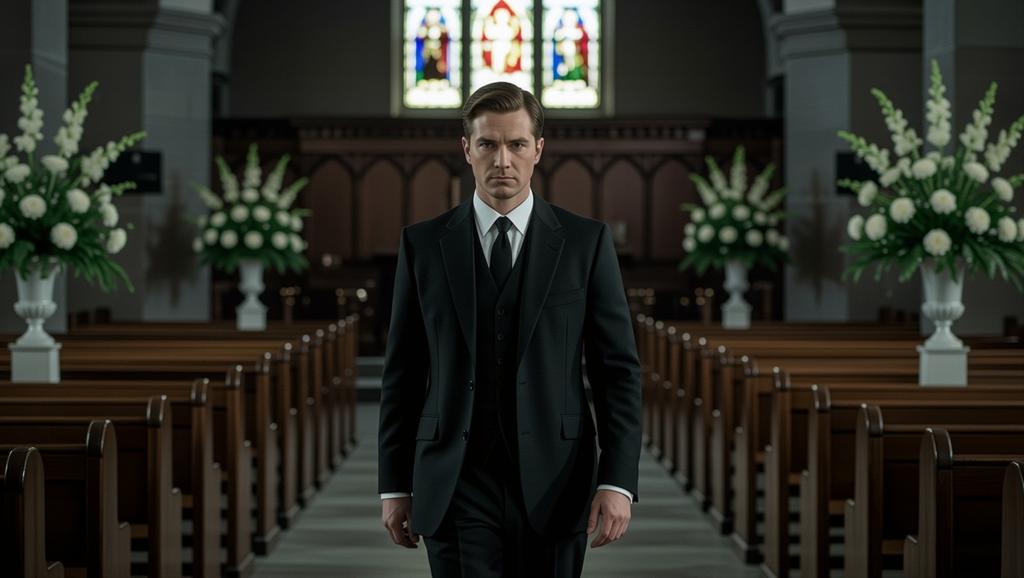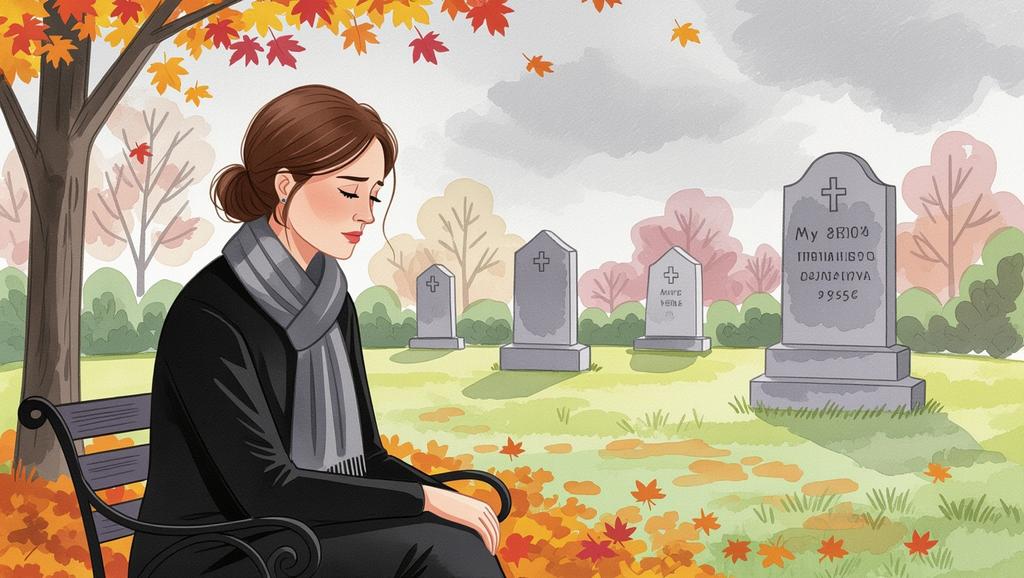The history of wearing black at funerals
Origins of the tradition
The practice of wearing black to funerals can be traced back to ancient times. One of the earliest recorded instances of this tradition comes from ancient Rome, where mourners donned a darker coloured toga known as the toga pulla. This was a significant departure from the usual white toga, signaling to others that the wearer was in mourning. The toga pulla was a way for people to visibly express their grief and solidarity with the bereaved without the need for words.

As centuries passed, the tradition evolved and spread to other cultures. By the Middle Ages, black had become closely associated with mourning, particularly among the wealthy. Black clothing was expensive and difficult to produce, making it a symbol of both grief and social status. Wealthy individuals wore black to show respect for the deceased and to publicly display their loss. This practice was not just about mourning; it was also a statement of one’s financial standing.
The Victorian era further solidified the tradition of wearing black at funerals. Queen Victoria’s profound grief following the death of her husband, Prince Albert, in 1861, set a powerful example. She wore black mourning clothes for the rest of her life, influencing mourning etiquette across the Western world. The period saw strict rules about the duration and type of mourning attire, with widows expected to wear full mourning for at least a year. This era marked the peak of black as the universal color of mourning in Western culture.
Evolution of funeral attire
Over time, the tradition of wearing black at funerals has evolved, influenced by social changes and cultural shifts. While black remains a staple, the strict rules of mourning attire from the Victorian era have relaxed. Today, the choice of funeral attire often reflects the personality of the deceased and the wishes of the family. Some families request that attendees wear the deceased’s favorite color or dress in a way that celebrates their life.
For instance, at my friend’s father’s funeral back when I was 18, she chose to wear a bright, flowery dress. It was her way of honoring her father’s love for life and nature. This personal touch made the funeral feel more like a celebration of his life rather than a somber event. It was a powerful reminder that while traditions are important, personal expression can be equally meaningful in times of grief.
The evolution of funeral attire also reflects broader fashion trends. In recent years, there’s been a noticeable shift towards more casual and comfortable clothing at funerals. This change is partly due to a desire to create a more relaxed and warm atmosphere, allowing mourners to feel more at ease during a difficult time.
Cultural significance of black at funerals
Symbolism of the color black
Black has long been associated with solemnity, dignity, and respect. It’s a color that conveys a depth of feeling, making it a natural choice for marking loss. The somber nature of black helps to focus the attention on the person being honored rather than on the attendees’ outfits. It also brings a sense of unity among mourners, symbolizing a collective respect for the deceased.
In many Western cultures, black is seen as the color of mourning because it represents the absence of light and life. This symbolism can be comforting to those grieving, as it mirrors their internal feelings of loss and emptiness. Wearing black can also serve as a small but meaningful ritual, helping mourners to feel grounded and connected to the person they are remembering.
Variations across different cultures
While black is predominant in Western funeral traditions, other cultures have different customs. In many Eastern cultures, for example, white is the traditional color of mourning. In countries like China and India, white symbolizes purity and peace, offering a different but equally powerful way of expressing grief.

Other cultures have their own unique colors associated with mourning. In Thailand, purple is worn to signify mourning, while in Myanmar and Egypt, yellow is the color of choice. In Iran, blue is used to represent grief. These variations highlight the diverse ways in which different societies honor their dead and express their mourning.
The choice of color in funeral attire often reflects deeper cultural beliefs and values. Understanding these differences can help us appreciate the rich tapestry of human traditions and the universal nature of grief.
Psychological impact of wearing black to funerals
Emotional effects on mourners
Wearing black to a funeral can have a profound psychological impact on mourners. The color black is often associated with sadness and loss, and wearing it can intensify these emotions. For many, putting on black clothing is a way to outwardly express their inner grief, providing a sense of solidarity with others who are mourning.
The act of dressing in black can also offer a sense of structure and comfort during a time of chaos and uncertainty. Familiar customs like wearing black can help mourners feel grounded when emotions are overwhelming. It’s a small but meaningful ritual that can provide a sense of control and connection to the person being remembered.
Perception by others
The perception of black at funerals by others can vary. In many cases, seeing mourners in black can reinforce the solemnity of the occasion, signaling to others the gravity of the event. It can also convey a sense of respect and empathy for the bereaved, showing that the attendees are there to support them in their time of need.
However, some may perceive the strict adherence to black as overly formal or even oppressive. In recent years, there’s been a growing trend towards more personalized funeral attire, reflecting the deceased’s life and personality. This shift can help to create a more inclusive and supportive environment for mourners, allowing them to express their grief in a way that feels authentic to them.
Modern trends in funeral attire
Shifting away from traditional black
In recent years, there’s been a noticeable shift away from the traditional black at funerals. Many families now request that attendees wear colors or styles that reflect the deceased’s personality or favorite colors. This trend towards personalization can make the funeral feel more like a celebration of life rather than a somber event.
For example, if the deceased loved bright colors or had a favorite sports team, mourners might be encouraged to wear those colors or team jerseys. This approach not only honors the deceased but also allows mourners to feel more connected to them during the service. It’s a way of celebrating their life and the joy they brought to others.
Influence of fashion trends
Fashion trends have also influenced funeral attire. As casual and comfortable clothing becomes more popular in everyday life, it’s increasingly common to see these styles at funerals. The desire for a more relaxed and warm atmosphere at funerals has led to a shift away from formal suits and dresses towards more casual options like jeans and sweaters.
This change reflects a broader cultural shift towards informality and comfort. It’s a way of acknowledging that while funerals are solemn occasions, they can also be a time for celebrating the life of the deceased in a way that feels true to their personality and values.
Read more Is your workwear hurting your confidence?
Practical considerations for choosing funeral attire
Etiquette and respect
When choosing what to wear to a funeral, it’s important to consider etiquette and respect. If the family has given specific guidance on what to wear, it’s best to follow their wishes. This could include wearing a particular color or style that reflects the deceased’s life and personality.
If no preferences have been shared, choosing something respectful and understated is a safe approach. Dark colors like black, navy, grey, or dark green are still widely appreciated, as they convey a sense of solemnity and respect. However, the most important thing is to show care and consideration through your attire.
Comfort and appropriateness
Comfort is another key consideration when choosing funeral attire. Funerals can be long and emotionally draining, so it’s important to wear something that allows you to feel at ease. This might mean opting for a more casual outfit or choosing clothing that is comfortable to sit and stand in for extended periods.
Appropriateness is also crucial. While it’s becoming more common to see casual and colorful outfits at funerals, it’s still important to consider the setting and the wishes of the family. If in doubt, it’s always best to err on the side of caution and choose something more formal and conservative.
Conclusion: Understanding the role of black in funeral fashion
The tradition of wearing black to funerals has deep historical roots, evolving from ancient Roman customs to the strict mourning etiquette of the Victorian era. Today, while black remains a symbol of solemnity and respect, funeral attire is increasingly personalized, reflecting the deceased’s life and personality.
The psychological impact of wearing black can be profound, offering mourners a sense of structure and comfort during a difficult time. However, the perception of black at funerals can vary, with some preferring more colorful and casual options to celebrate the life of the deceased.
Ultimately, the choice of funeral attire should be guided by the wishes of the family and a desire to show respect and support. Whether it’s traditional black or a more personalized approach, what matters most is the love and care we show for those who are grieving. As we continue to evolve our funeral customs, it’s important to remember that the most meaningful way to honor the dead is by celebrating their life and the impact they had on us.














